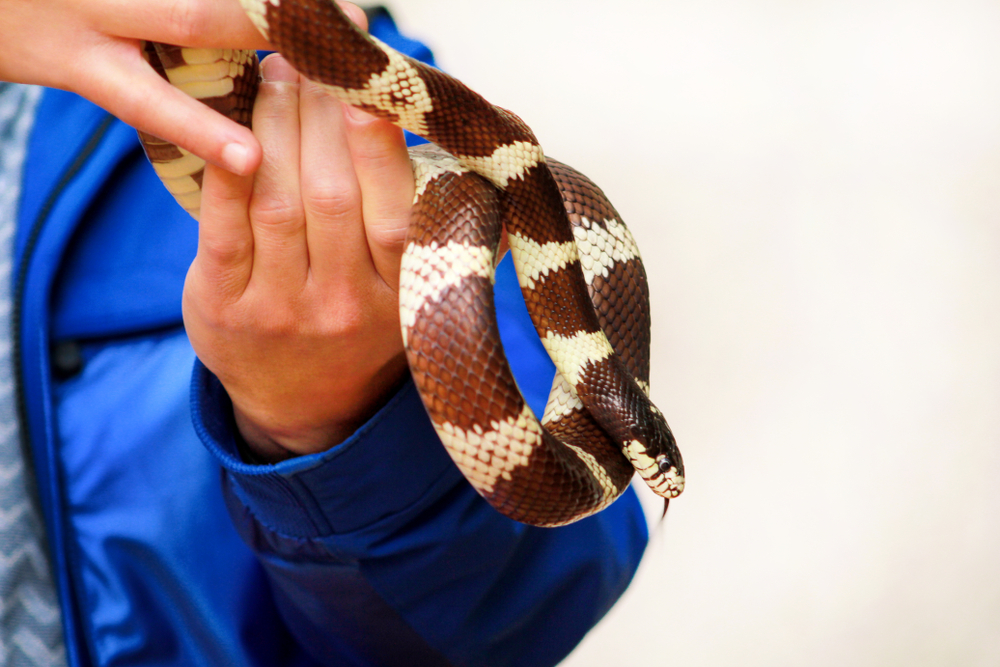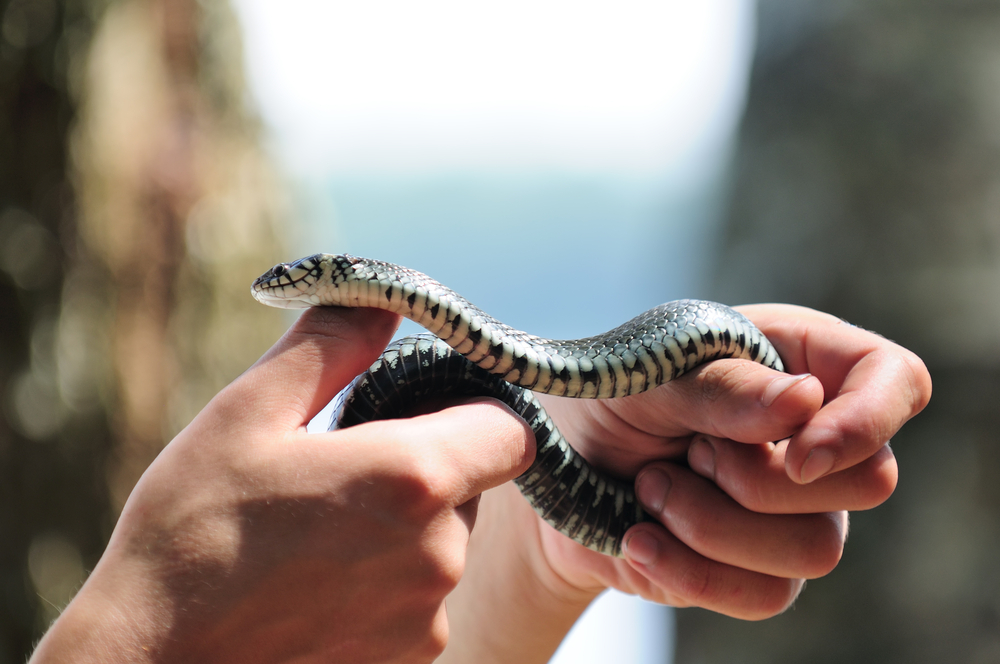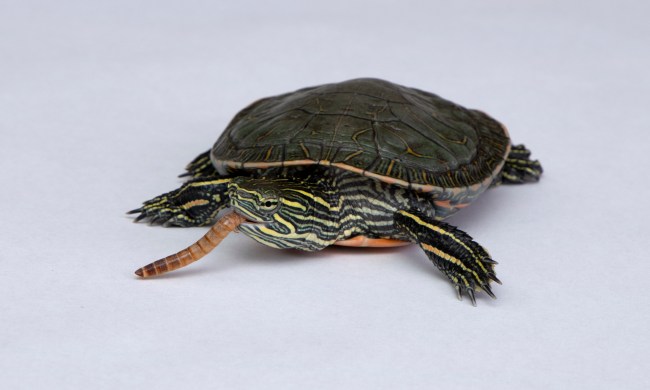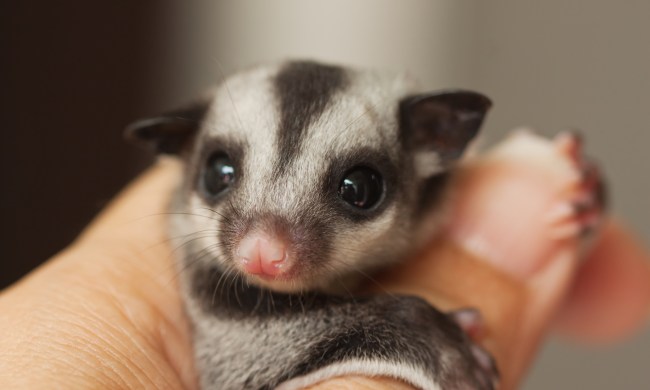If you’re looking for some animal companionship but your landlord doesn’t allow dogs and cats, consider adopting a snake. Contrary to popular belief, they make great pets. In fact, there are those who believe that some snakes are affectionate reptiles. Although they will never be described as cuddly, many varieties love to be handled, are very low-maintenance, and rarely bite. Here are three nonvenomous varieties that love to be handled.
Corn Snake ($40-$1,000)
The corn snake is native to the Southeastern United States. These social snakes, active mainly at dusk and dawn, take their name from corn granaries where they are often found hunting mice. Colorful in nature, corn snakes can be yellow, orange, or brownish-yellow with red patches outlined in black. Black and white markings on their underside resemble a checkerboard design. They grow to a length of almost 6 feet and can live as long as 23 years in captivity.
- Behavior: Corn snakes are among the most gentle snakes, which is why they make good pets. They rarely bite when threatened. Instead, they will try to get away or rattle the tip of its tail as a warning. Striking is a last resort and, when it happens, it rarely draws blood.
- Diet: In the wild, a corn snake will eat rodents, birds, other snakes, and small lizards. You will want to feed them frozen-thawed mice or rats, which you can buy at your local pet store. Feeding your snake live prey is not recommended, as they may have parasites and can bite and injure your pet. Healthy adult snakes eat every seven to 10 days, and depending on its size, will eat between one to three mice.
- Habitat: Your corn snake will be happiest in a long glass container with a lid that fits securely. One side of the container should be warmed to between 80-85 degrees during the day and no lower than 75 degrees at night. The other side of the tank should contain a heavy shallow dish filled with clean water. Because these snakes like to burrow, they’ll also need suitable places to hide on both sides of the container.
Kingsnake ($40-$200)

Kingsnakes, also known in some regions as milk snakes, are docile snakes found in southern Canada as well as throughout the United States and Central and South America. Most are black in color with pale yellow bands the length of its body; some also have red bands. Kingsnakes average 5 feet in length when fully grown and can live as long as 15 years.
- Behavior: Once a kingsnake trusts you, it is easy to handle. When frightened, they emit a musky scent and rattle the tip of their tail. They are constrictors so may wrap themselves around your arm, which is harmless. Their bites are infrequent and painless, typically occurring because they’ve mistaken your finger for prey.
- Diet: Just like corn snakes, kingsnakes eat pre-killed, frozen mice and rats that have been thawed to room temperature. A healthy adult snake will eat once a week, and young snakes eat twice a week. It’s also important to provide them with a supply of clean water.
- Habitat: Kingsnakes are very active and like a lot of room to move around. For this reason, you’ll want to invest in a large glass tank at least 20 gallons in size with a lid that fits securely. You’ll want to separate the tank into two living zones. One with a warming pad that keeps a temperature of 70-85 degrees during the day and 55-70 during the night, and the other cooler side where you can place its water dish. They like to hide, so use natural rocks and branches or purchase commercial hiding places from your local pet store.
Garter Snake ($20-$300)
Garter snakes are common in North America. Gardeners love them because they keep their beds free of rodents and other garden pests like slugs, insects, and grasshoppers. Color varies among the 35 species of garter snakes, but most are recognizable by their gray, brown, black, or olive coloring. Female garter snakes can grow to a length of 3 feet, and males grow to as long as 2 feet. In captivity, garter snakes can live as long as 10 years.
- Behavior: Garter snakes are active during the day and do not constrict. These docile snakes are wiggly and may emit a musky odor when frightened.
- Diet: Primarily, your garter snake will thrive on a diet of pre-killed frozen mice that have been thawed to room temperature. They will also enjoy the occasional earthworm, whole feeder fish, and frogs or toads. Adult snakes eat every seven to 10 days, while youngsters need to eat every four to five days. They also need fresh water daily.
- Habitat: Use a 30 to 50-gallon aquarium or plastic tub to house your garter snake and make sure it has a tight-fitting lid to prevent escapes. One side of the tank should be warmed to a constant temperature in the high 80s, and the other side should not be cooler than the mid-70s. Make sure the environment includes several places for them to hide, large rocks for them to rub against when it’s time to shed, and a dish of water where they can soak to stay hydrated.
How to handle a snake

Each snake has its own personality, and once your snake gets to know and trust you, you’ll be able to handle it confidently. Here are a few tips to get you started:
- Wash your hands. Not only will this prevent you from transferring any bacteria to your snake, it also prevents the possibility your snake will mistake the scent on your hands as food.
- Let it get to know you. Spend some time letting your snake become familiar with your presence by placing your hand in its enclosure for a few minutes several times a day before you try to pick it up.
- Pick it up gently using both hands. Once it becomes accustomed to your scent, you can pick your snake up from the midsection. Use one hand to support the top third of the snake and the other to hold the bottom third. It may try to stabilize itself by wrapping around your arm, which is normal and harmless.
- Be respectful. If your snake is shedding, eating, or hissing, leave it alone.
- Stay calm. Like other animals, your snake has its own personality. It may be afraid of being handled at first. Try not to startle it by moving too quickly.
- Close the lid securely. Snakes are great escape artists and will explore ways in which to explore beyond its enclosure, no matter how comfortable you’ve made it for them.
- Wash your hands again. Snakes carry a bacteria known as salmonella, which can make you sick.
In the wild, snakes are benevolent creatures that keep the rodent and insect population in balance. As pets, they provide low-maintenance, allergy-free companionship. When treated with respect and provided with proper snake care, they can live a long and healthy life and be a fun topic of conversation with your family and friends.


